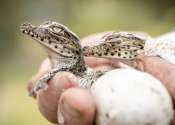Cryptodira
Pleurodira
and see text
Turtles are reptiles of the order Testudines (the crown group of the superorder Chelonia), characterised by a special bony or cartilaginous shell developed from their ribs that acts as a shield. "Turtle" may either refer to the Testudines as a whole, or to particular Testudines which make up a form taxon that is not monophyletic—see also sea turtle, terrapin, tortoise, and the discussion below.
The order Testudines includes both extant (living) and extinct species. The earliest known turtles date from 215 million years ago, making turtles one of the oldest reptile groups and a more ancient group than lizards and snakes. About 300 species are alive today, and some are highly endangered.
Like other reptiles, turtles are ectotherms—varying their internal temperature according to the ambient environment, commonly called cold-blooded. Like other amniotes (reptiles, dinosaurs, birds, and mammals), they breathe air and do not lay eggs underwater, although many species live in or around water. The largest turtles are aquatic.









